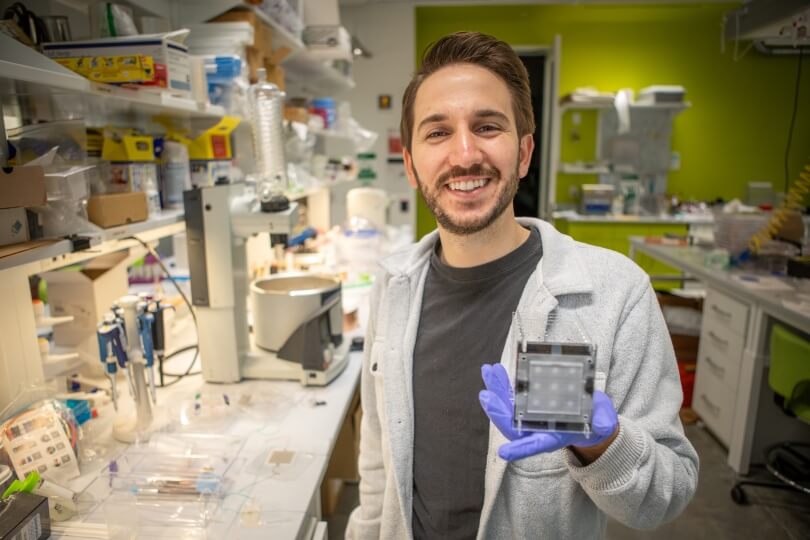Gino Domel, Ph.D. candidate in materials science and mechanical engineering (Eliza Grinnell/SEAS)
Gino Domel grew up in a tight-knit community of friends and family in a northwestern suburb of Chicago. As a mechanical engineering major at Notre Dame, he found himself drawn to the community formed through the school’s hall system, which he described as similar to the Harvard undergraduate house system. When he started his Ph.D. program in materials science and mechanical engineering (MS/ME) at the Harvard John A. Paulson School of Engineering and Applied Sciences (SEAS), Domel sought ways to build a community at his new school.
“It always comes back to the people,” Domel said. “Something my family says is it’s the people, not the place. Harvard brings a lot of pretty special people together. The friends, the community, the mentors, those will be what I remember the most.”
Domel first came to SEAS as an undergraduate summer researcher. His older brother August Domel, Ph.D. ‘19, was in the lab of Katia Bertoldi, William and Ami Kuan Danoff Professor of Applied Mechanics at SEAS, and Gino applied for a research grant at Notre Dame to join them and Dr. George Lauder in 2017 and 2018. While here, he contributed to a publication on the relationship between sharks’ swim speed and the tooth-like structures on their skin called denticles.
“I really fell in love with Cambridge and Boston and the atmosphere around Harvard,” Gino Domel said. “It’s a really lively place with a lot of interesting things happening, and a lot of great people as well. That combination of the people, place and work being done really interested me and inspired me to come back.”
For his Ph.D. research, Domel joined the Materials Discovery and Applications Group of David R. Clarke, Extended Tarr Family Professor of Materials. His research has focused on soft robotics and, more specifically, the actuators that enable them to move.
“We’re exploring making these actuators to achieve different goals, such as enabling devices powered by ultraviolet light, or pumping fluids in wearable devices,” Domel said. “Cooling and heating can be done by the movement of fluid, and there are many types of actuators that work through the flow of liquids or air. With UV light-controlled actuators, a lot of my research is in reducing the complexity of how some of these devices are built. For example, we’re trying to build a display controlled by the lights under it.”
Robots made from soft materials have several potential advantages over traditional ones made from harder materials like metal or plastic, especially when it comes to wearable devices. Soft robotics tend to weigh much less, making them more accessible for people with reduced strength. Their materials also tend to be cheaper to source and assemble, making them more affordable for users.
“If a soft-materials robot gets deformed a little, it’s less likely to break than a hard-materials robot,” Domel said. “Soft materials also tend to interface better with skin and human touch. Most people would rather feel these soft materials than some hard metal or plastic, so it makes a big difference.”
When he’s not in the lab, Domel has worked to build community among his fellow materials science and mechanical engineering students. In his first year, along with fellow MSME student Jordan Sosa, he co-founded the MS/ME Graduate Organization, serving as vice president and continuing to stay involved with the group throughout his five years at SEAS.
“It’s a way for MS/ME students to know each other and start building those relationships,” he said. “That’s something we saw in other departments at SEAS, and we’re trying to recreate that in our own department. It’s really helpful because you get to interact with grad students outside of class or your lab.”
Domel is also a Student Center Athletics Fellow in the Harvard Griffin Graduate School of Arts and Sciences, a role his older brother also held while at SEAS. He’s organized a range of programming and events, including fantasy football leagues, March Madness bracket challenges, Celtics viewing parties, spikeball tournaments, bike maintenance workshops, and a graduate student intramural sports league.
“I loved playing intramural sports in college, and I was really excited to come here and play them again,” he said. “I wanted to help give grad students a new option, because we all know how important having that community is while you’re here. Seeing this project from the beginning to where it is now is something I’m really passionate about and wanted to make sure happened.”
After graduation, Domel intends to join a lab at Northwestern University to help a new startup called HiDeNN-AI spin out of the lab.
“I’ll be helping it basically get out of the lab,” he said. “They use their neural network IPs to solve different engineering problems, so it’s a bridge between AI and mechanical engineering. They’re still exploring the best problems to solve with their technology, but it could be generally described as using well-informed neural networks to solve engineering problems.”
Press Contact
Matt Goisman | mgoisman@g.harvard.edu
